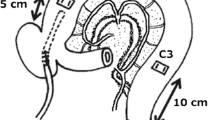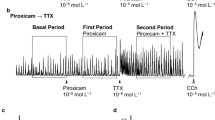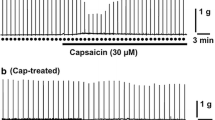Summary
The sites of action and possible roles of substance P in contracting the circular muscle of the guinea-pig ileum were studied using two analogues of substance P that act as antagonists of some of its actions. These ared-Arg1,d-Pro2,d-Trp7,9, Leu11-substance P andd-Pro2,d-Trp7,9-substance P, referred to by the single letter amino acid codes for the substituting amino acids as (RPWWL)-SP and (PWW)-SP, respectively.
Records of circular muscle activity were taken from strips of intestine free of mucosa and submucosa and from rings with all layers of intestine intact. Substance P was equally effective in contracting the circular muscle strips as it was in contracting the longitudinal muscle. The contractions of strips were not blocked by hyoscine (2×10−6 M) or tetrodotoxin (6×10−7 M), but were substantially reduced by (RPWWL)-SP (6.7×10−6 M) or (PWW)-SP (2×10−5 M). In contrast, contractions of the circular muscle of whole rings of intestine elicited by low concentrations of substance P (4×10−7M) were blocked by hyoscine or tetrodotoxin but notreduced by the substance P antagonists in the concentrations referred to above. These observations indicate that the antagonists are effective at receptors for substance P on the muscle, but not at substance P receptors on enteric cholinergic nerves.
Transmural stimulation of strips of circular muscle or of intestinal rings in the presence of hyoscine evoked contractions that were blocked by tetrodotoxin. These hyoscineresistant, nerve-mediated contractions could be elicited by single pulses in the strips. The contractions were reduced to less than 20% of original amplitude by (RPWWL)-SP (6.7×10−6M).
Reflex contractions of the circular muscle recorded on the oral side of a distension stimulus had a low-threshold, hyoscine-sensitive and a high-threshold, hyoscine-insensitive, component. The low threshold component was unaffected by the substance P antagonists whereas the high threshold component was depressed.
It is concluded that substance P nerves are effective in transmitting to the circular muscle, that they are final nerves in non-cholinergic excitatory reflexes, and that the substance P antagonist analogues can be used to distinguish actions of substance P at neural and muscle receptors.
Similar content being viewed by others
References
Ambache N, Freeman, M (1968) Atropine-resistant longitudinal muscle spasms due to excitation of non-cholinergic neurons in Auerbach's plexus. J Physiol 199:705–727
Baron SA, Jaffe BM, Gintzler AR (1983) Release of substance P from the enteric nervous system: direct quantitation and characterization. J Pharm Exp Ther 227:365–370
Barthó L, Holzer P, Donnerer J, Lembeck F (1982) Evidence for the involvement of substance P in the atropine-resistant peristalsis of the guinea-pig ileum. Neurosci Letts 32:69–74
Bywater RAR, Holman ME, Taylor GS (1981) Atropine-resistant depolarization in the guinea-pig small intestine. J Physiol 316: 369–378
Bywater RAR, Taylor GS (1983) Non-cholinergic fast and slow post-stimulus depolarization in the guinea-pig ileum. J Physiol 340:47–56
Björkroth U (1983) Inhibition of smooth muscle contractions induced by capsaicin and electrical transmural stimulation by a substance P antagonis Acta Physiol Scand Suppl 515:11–16
Brownlee G, Harry J (1963) Some pharmacological properties of the circular and longitudinal muscle strips from the guinea-pig isolated ileum. Br J Pharmacol 21:544–554
Costa M, Cuello AC, Furness JB, Franco R (1980) Distribution of enteric neurons showing immunoreactivity for substance P in the guinea-pig ileum. Neuroscience 5:323–331
Costa M, Furness JB (1976) The peristaltic reflex: an analysis of the nerve pathways and their pharmacology. Naunyn-Schmiedeberg's Arch Pharmacol 294:47–60
Costa M, Furness JB (1982) Nervous control of intestinal motility. Handbook of Exp Pharmacol 59:279–382
Costa M, Furness JB, Franco R, Llewellyn-Smith IJ, Murphy R, Beardsley AM (1982a) Substance P in nerve tissue in the gut. In: Substance P in the nervous system, Ciba Foundation Symposium. 91, Pitman, London, pp 129–144
Costa M, Furness JB, Franco R, Llewellyn-Smith IJ, Papka RE, Murphy R (1982b) Substance P in the intestine. In: Yoshida H, Hagihara S, Ebashi S (eds) Advances in pharmacology and therapeutics II, vol 1. Permagon Press, Oxford, pp 103–114
Costa M, Furness JB, Llewellyn-Smith IJ, Cuello AC (1981) Projections of substance P neurons within the guinea-pig small intestine. Neuroscience 6:411–424
Donnerer J, Barthó L, Holzer P, Lembeck F (1984) Intestinal peristalsis associated with release of immunoreactive substance P. Neuroscience 11:913–918
Franco R (1980) The effect of substance P on the circular muscle of the intestine: evidence that substance P stimulates cholinergic nerves. Proc Aust Physiol Pharmacol Soc 11: 17P
Franco R, Costa M, Furness JB (1979a) Evidence for the release of endogenous substance P from intestinal nerves. Naunyn-Schmiedeberg's Arch Pharmacol 306:195–201
Franco R, Costa M, Furness JB (1979b) Evidence that axons containing substance P in the guinea-pig ileum are of intrinsic origin. Naunyn-Schmiedeberg's Arch Pharmacol 307:57–63
Fujisawa K, Ito Y (1982) The effects of substance P on smooth muscle cells and on neuro-effector transmission in the guineapig ileum. Br J Pharmacol 76:279–290
Furness JB (1969) An electrophysiological study of the innervation of the smooth muscle of the colon. J Physiol 205:549–562
Furness JB, Costa M (1976) Ascending and descending enteric reflexes in the isolated small intestine of the guinea-pig. Proc Aust Physiol Pharmacol Soc 7:172P
Gintzler AR, Hyde D (1983) A specific substance P antagonist attenuates non-cholinergic electrically induced contractures of the guinea-pig isolated ileum. Neurosci Letts 40:75–79
Håkanson R, Hörig J, Leander S (1982) The mechanism of action of a substance P antagonist (d-Pro2,d-Trp7,9)-SP. Br J Pharmac 77:697–700
Harmar AJ (1984) Three tachykinins in mammalian brain. Trends in Neurosciences 69:57–60
Hirst GDS (1979) Mechanism of peristalsis. Br Med Bull 35:263–268
Holzer P (1984) Characterization of the stimulus-induced release of immunoreactive substance P from the myenteric plexus of the guinea-pig small intestine. Brain Res 297:127–136
Holzer P, Lembeck F, Donnerer J (1980) Caerulein, substance P, serotonin, and cholinomimetics induce rhythmic contractions of the intestinal circular muscle. Naunyn-Schmiedeberg's Arch Pharmacol 312:131–137
Katayama Y, North RA, Williams JT (1979) The action of substance P on neurons of the myenteric plexus of the guinea-pig small intestine. Proc R Soc Lond B 206:191–208
Lee C-M, Iversen LL, Hanley MR, Sandberg BEB (1982) The possible existence of multiple receptors for substance P. Naunyn-Schmiedeberg's Arch Pharmacol 318:281–287
Nemeth PR, Ewart WR, Wood JD (1983) Effects of the putative substance P antagonists (d-Pro2,d-Phe7,d-Trp9, andd-Pro2,d-Trp7,d-Trp9) on electrical activity of myenteric neurons, J Auto Nerv Sys 8:165–169
Nieber K, Milenov K, Bergmann J, Oehme P (1981) Contractile response of longitudinal and circular smooth muscles of guinea pig stomach and ileum to substance P. Acta Biol Med 40:209–216
Pernow B (1983) Substance P. Pharmacol Rev 35:85–141
Rosell S, Björkroth U, Xu J-C, Folkers K (1983) The pharmacological profile of a substance P (SP) antagonist. Evidence for the existence of subpopulations of SP receptors. Acta Physiol Scand 117:445–449
Schultzberg M, Hökfelt T, Nilsson G, Terenius L, Rehfeld J, Brown M, Elde R, Goldstein M, Said SI (1980) Distribution of peptide and catecholamine neurons in the gastrointestinal tract of rat and guinea-pig: immunohistochemical studies with antisera to substance P, VIP, enkephalins, somatostatin gastrin, neurotensin and dopamine-β-hydroxylase. Neuroscience 5:689–744
Tonini M, Gianmario F, Lecchini S, D'Angelo L, Crema A (1981) Hyoscine-resistant peristalsis in guinea-pig ileum. Eur J Pharmacol 71:375–381
Trendelenburg P (1917) Physiologische und pharmakologische Versuche über die Dünndarmperistaltik. Arch Exp Pathol Pharmacol Bd 81:55–129
Author information
Authors and Affiliations
Rights and permissions
About this article
Cite this article
Costa, M., Furness, J.B., Pullin, C.O. et al. Substance P enteric neurons mediate non-colinergic transmission to the circular muscle of the guinea-pig intestine. Naunyn-Schmiedeberg's Arch. Pharmacol. 328, 446–453 (1985). https://doi.org/10.1007/BF00692914
Received:
Accepted:
Issue Date:
DOI: https://doi.org/10.1007/BF00692914




